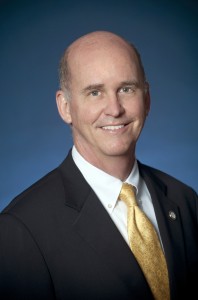 By Thomas M. Mengler, J.D., president of St. Mary’s University
By Thomas M. Mengler, J.D., president of St. Mary’s University
The brilliance of Steven Spielberg’s movie “Lincoln” is its nuanced portrayal of Abraham Lincoln’s wisdom, craftiness and compassion. As a university educator, I left the movie theater over Thanksgiving wondering what kind of education is necessary today to educate a magnificent leader like Lincoln, who most historians rank as our finest president.
Lincoln’s education derived significantly, though not solely, from the breadth and depth of his reading. One of young Lincoln’s contemporaries unflatteringly characterized him as a “very lazy man” because he was “always reading – scribbling – writing – ciphering – writing Poetry.” Lincoln himself credited the source of his wisdom and knowledge to expansive reading: “All I have learned, I learned from books.” Lincoln was drawn to math, especially Euclid’s works on geometry. In an important scene in Spielberg’s movie, President Lincoln advocates for equality among all people by quoting Euclid’s principle that things equal to the same thing are also equal to one another.
Lincoln also studied theology, especially the Bible, and his most important speeches contain frequent references to scripture. He loved poetry and was particularly fond of several of Shakespeare’s plays, including Richard III, King Lear and Macbeth, which he could recite by heart. And Lincoln the lawyer had read the most significant law texts of his time, including Blackstone’s Commentaries on the Laws of England.
Lincoln, as we know, was self-taught, reading and studying by himself. Even Lincoln’s study of the law was solitary and thus atypical, since most lawyers in 19th century America learned the law under the apprenticeship of an experienced senior lawyer. One might be tempted to conclude, therefore, that an education like the one Lincoln received can occur in solitude, in your pajamas, in front of a computer screen.
Lincoln’s education, however, would suggest otherwise. As a lawyer in rural Illinois in the 1840s and 1850s, Lincoln continued his transformation from backwoods youth to moral leader while “riding the circuit.” During that period, lawyers and judges in rural America would ride from town to town, trying local cases. Most towns in central Illinois, where Lincoln rode the circuit, were too sparsely populated to have a judge or even a lawyer. At the end of every day after the court session, the circuit judge and lawyers would swap stories, discuss the most vital moral and political issues of the times, and build friendships. They grew as men around a campfire through discussion and reflection.
The modern equivalent to Lincoln’s education, I would argue, is the kind of education – a values-based liberal arts education on a residential campus – St. Mary’s University and many other fine liberal arts institutions have provided for a long time. It is an education where students read broadly and deeply, think critically, and learn to write and speak effectively, though a nurturing community where faculty and staff facilitate the shaping of students’ hearts as well as minds. It is not a drive-thru, discount model of education. No, the lesson of Lincoln’s education is that the transformative education of young adults into ethical leaders is hard work, collaborative and multidimensional.
After you see Spielberg’s “Lincoln,” ask yourselves, what kind of education produces a leader who, as the bloodiest war in our history ended, exhorted the American people:
With malice toward none;
with charity for all;
with firmness in the right,
as God gives us to see the right,
let us strive on to finish the work we are in.
The moral of Lincoln’s story may be that some things – like the value of a liberal arts education – don’t change. The good and the true should endure.
